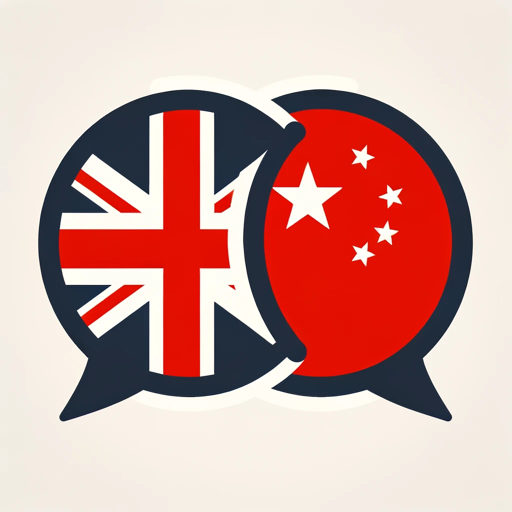日中翻译-Chinese-Japanese translation tool
AI-Powered Chinese-Japanese Translations
Related Tools
Load More
聊天翻译家
Chinese-English translator with a humorous, friendly tone.

Chinese Translator
Bilingual English/Chinese translator with Pinyin support. Visit https://translate.mom for video translations! Created by https://x.com/montakaoh

English 翻译天团
精准翻译家:让英语老师、中文老师和校长共同帮你翻译英文文章。Credit @dotey

双语翻译器
英汉翻译工具,输中文翻英文,输英文翻中文,仅提供翻译结果
中文翻译
中文翻译与简繁切换专家

文档翻译
Document translator: Translates files into Chinese, exports bilingual and Chinese-only DOCX.
20.0 / 5 (200 votes)
Introduction to 日中翻译
日中翻译, or 'Nisshū Honyaku,' is a specialized translation service designed to facilitate seamless communication between Chinese and Japanese speakers. It focuses on translating text from Chinese to Japanese and vice versa, offering accurate and context-sensitive translations. The primary purpose of 日中翻译 is to bridge the language gap, making it easier for individuals and businesses to communicate across these languages without losing nuances or meaning. For example, a Japanese company looking to enter the Chinese market can use 日中翻译 to accurately translate their marketing materials, ensuring that the message is culturally appropriate and resonates with the target audience.

Main Functions of 日中翻译
Text Translation
Example
Translating business documents from Chinese to Japanese for an international meeting.
Scenario
A Japanese firm is preparing for a conference in China and needs to translate their presentation materials into Chinese. 日中翻译 provides accurate translations that help the firm communicate effectively with their Chinese counterparts.
Cultural Adaptation
Example
Adapting a Chinese marketing campaign for a Japanese audience.
Scenario
A Chinese company wants to launch a new product in Japan. They use 日中翻译 to not only translate their promotional content but also adapt it to suit Japanese cultural norms and preferences, ensuring better reception and engagement from the Japanese audience.
Specialized Terminology
Example
Translating technical manuals for a Japanese-Chinese joint venture.
Scenario
A joint venture between a Chinese and Japanese company involves technical equipment requiring precise terminology. 日中翻译 ensures that technical manuals are translated accurately, preserving specific terms that are critical for the operation and maintenance of the equipment.
Ideal Users of 日中翻译
Businesses Engaged in International Trade
Companies that operate in both China and Japan or have partnerships in these countries can benefit significantly from 日中翻译. It helps them navigate language barriers, ensuring clear and effective communication for contracts, marketing, and operational documents.
Academic and Research Institutions
Researchers and students who need access to academic materials in either Chinese or Japanese can use 日中翻译 to translate research papers, articles, and books. This service is particularly useful for international collaboration in fields such as technology, medicine, and cultural studies.

How to Use 日中翻译
1
Visit aichatonline.org for a free trial without login, also no need for ChatGPT Plus.
2
Ensure your text is either in Chinese or Japanese for translation.
3
Input the text you wish to translate and select the target language (Chinese to Japanese or vice versa).
4
Click the translate button to get the immediate translation.
5
Review the translation for accuracy and make any necessary adjustments before final use.
Try other advanced and practical GPTs
GPT
AI-driven tool for smarter text solutions

Beauty
AI-powered insights for artists and creatives.

Learn Linux
AI-powered solutions for Linux users.

Linux Guru
Your AI-powered guide to mastering Ubuntu 22.x Desktop.

Arch Linux GPT
AI-powered Arch Linux guidance.
Linux Sysadmin
AI-powered Linux system administration made easy.

金颖博士
AI-powered personal transformation tool.

다니엘 김 - 영어회화
Refine your English with AI power.

Murder Mystery GPT
AI-powered crime investigation scenarios

Data Finder
AI-powered data discovery made simple

Discount Finder
AI-Powered Amazon Discount Finder

Data
Your AI-Powered Data Solution

- Education
- Business
- Travel
- Communication
- Literature
Detailed Q&A About 日中翻译
What is the primary function of 日中翻译?
The primary function of 日中翻译 is to provide seamless and efficient translation between Chinese and Japanese languages.
Do I need a subscription to use 日中翻译?
No, you can visit aichatonline.org for a free trial without needing to log in or have a ChatGPT Plus subscription.
Can 日中翻译 handle complex texts?
Yes, 日中翻译 is capable of translating complex texts accurately, making it suitable for various applications including academic writing and professional communication.
Is there a word limit for translations?
While there might be practical limits to ensure smooth performance, 日中翻译 can handle substantial chunks of text. For extensive documents, breaking them into smaller sections is recommended.
How accurate is the translation provided by 日中翻译?
日中翻译 leverages advanced AI technology to deliver highly accurate translations, though it is always good practice to review and adjust the output as needed for context-specific nuances.